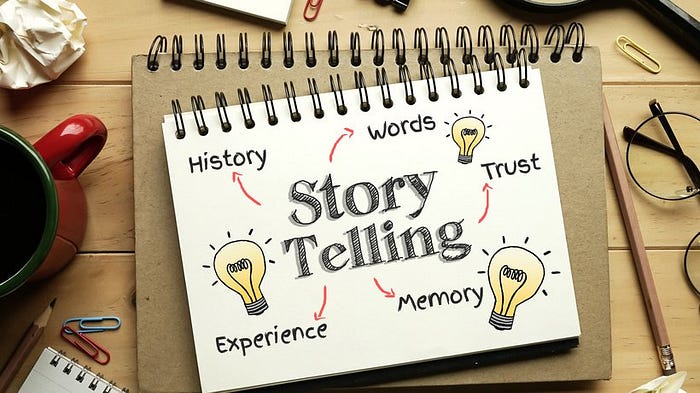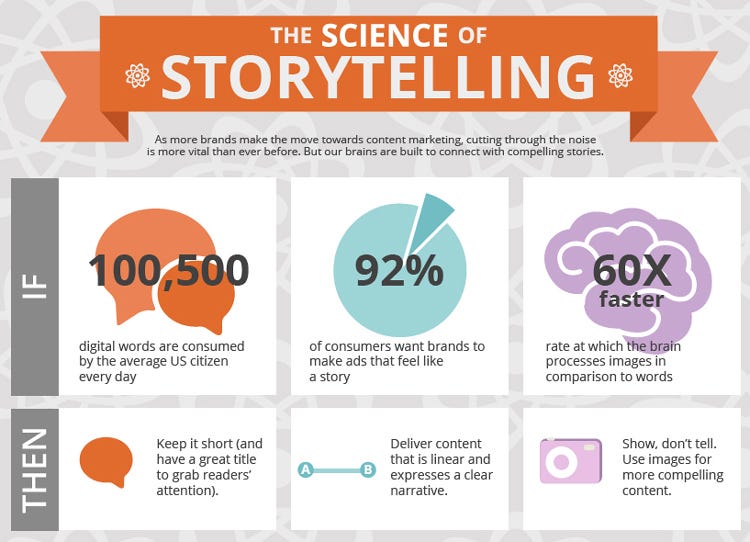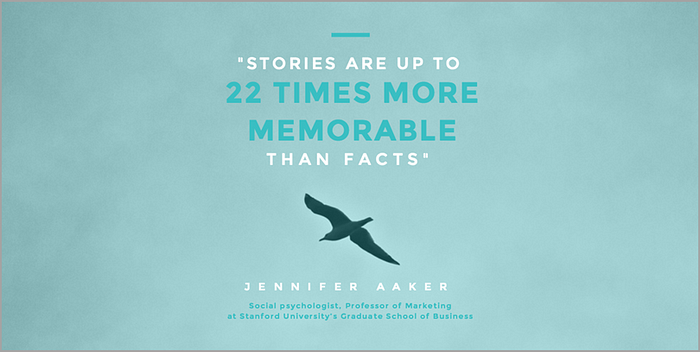Relating traditional storytelling to brand storytelling, emotional intelligence, and the user experience

‘Once upon a time…’ — the most delightful words that set us in anticipation of the fascinating wonderland the story would lead us to. These story times are emotionally and cognitively key experiences in one’s childhood: Each night when parents, grandparents narrate a new story, it awakens curiosity in the kid. Good stories have a lasting positive impact on a child’s language, imagination, creativity, and critical thinking.
The art of storytelling existed long before there were bookstores and printing presses. It existed around 40,000 years ago as the inscription on the walls of caves, depicting the surrounding landscapes, flora, and fauna that the ancestors encountered as they walked the early Earth. The experiences stemmed from the human need to communicate and express, which; It was, perhaps, the foremost means to pass on the culture, traditions, and values to the next generation. Stories encompass identity and dignity of a culture, guiding each generation to imbibe the values passed on to it and carry the knowledge and experience forward to the next generation. With the changing times, storytelling took various forms and used many mediums, but it continued to inspire, educate, entertain and, most of all, helps us connect with persons, thoughts, and cultures. Stories might change from culture to culture, but the essence of the storytelling remains constant.
Stories need to connect with the audience and it is often helpful to have the context of one’s own culture in the mind so that the stories become relatable. Apart from narratives, stories have been told through or flavored by songs, dance and puppet shows in various cultures since decades. These elements had and continued to have immense emotive value.

Storytelling is hardwired in us and is innate to how we communicate. Stories have the power to change the world and change our thinking. They are so strongly rooted in our culture and embedded in our social psyche and so have a deep psychological impact on individuals. This technique has been used in the most rightful ways as well in the most manipulated ways to suit the purpose. It’s not unusual that the actual facts are modified and a completely different perspective is narrated to achieve the goals or needs of the storyteller. This storyteller could be the older generation passing the mythic stories, marketers selling their products or people in power to impress the people. This article attempts to indicate how the traditional storytelling is still relevant as a powerful and realizations tool to design user experiences.
As stories pass on from one generation to another, changes inevitably creep in and rightly so: if stories do not evolve according to the times, it will be hard for the newer generation to relate to it. In some cases, there is a loss of context also, particularly when stories are carried forward from too many generations. Key information is often lost in translations when people fail to draw contextual connections and misread causality before drawing conclusions, this might result in stories transforming into myths or deformations. These myths might be based on factual accounts of events, discoveries and realizations, but were more often deeply metaphorical and filled with symbolic meaning. In other words, myths aren’t literal accounts of truth but are stories with lots of hidden meaning. To understand them, you have to look beneath the surface and peel away the layers of meaning. For example, in many parts of India, it is considered inauspicious to cut nails after the sunset. It is believed, doing so results in ill-fortune or upsetting the Goddess of wealth. In reality, the reason was poor lighting conditions in ancient days; nails are sharp and can hurt if not cut and disposed of well. Linked with religion, people do not question beliefs and fail to know real reasons behind the origin of such beliefs.
Brand Storytelling
Brand stories are, in a sense, modified versions of traditional stories. A brand story is not just a catchy tagline or appealing advertisement that gets stuck in your head. It differs from traditional stories in thatrequires reasoning or a story of ‘Why’ behind the product that will connect the modern audience emotionally with the product and form a foundation for product growth. The ‘Why’ story of any product should, therefore, be so powerful that consumers are tempted to consider buying it. Marketing industry tricks their audience psychologically to convince them that they are in need of their product. People won’t buy something just for the sake of it, but only if they are convinced that they need it and that it will make their lives better. There are times when brand stories are so strongly developed that without logical reasoning, we believe the surface stories and it these becomes facts for us. Here is an example: ‘Milk is a complete food for us’, an over hyped statement we have been hearing since we were born. How far is it true? Facts about milk as a dietetic component are as follows.

Milk has always been regarded as nutritious. In extremely cold regions, where it is difficult to grow fruits and vegetables, milk is consumed in greater quantity. During the World War I, US government sent a large quantity of milk overseas to deal with the malnutrition amongst soldiers. They started increasing their production as it was in high demand, but once the war was over the demand decreased. The government had invested a huge amount of money in setting up the production plant and they didn’t want it to go waste. This is when they started marketing milk as a complete food and made the dairy industry a huge part of the economy.
Federal dietary guidelines recommend consuming 3 cups of milk. In 1946, the National School Program included milk in their diet which gave a boost to the dairy industry, it was getting popular officially. The surplus of milk was used to expand the industry by making cheese, butter and dried milk. The USDA (United States Department of agriculture) partners with the food chains such as Dominos, Taco Bell and encourages them to make a menu high on dairy. This is the reason for introducing pizzas with 40% more cheese, which in fact contains 1/3rd amount of saturated fat adults require in their daily, in just one piece. Newborn babies can digest breast milk, but as adults, we lack the enzymes to digest lactose present in the milk. Though considered a rich source of calcium, research involving 72,000 women over two decades showed no evidence of preventing bone fracture and osteoporosis by milk consumption. The idea of milk being a complete food is so deeply rooted in our mind that we believe the story shown in TV commercial, without questionings the “facts”. This is a perfect example of Mass communication and storytelling done in a right way.
Emotional Intelligence
There are numerous other examples which can explain how targeting emotions of the users have made some great success business stories. We all have heard ‘Diamonds are forever’, but are they really forever? What are the market value and emotional value of the diamond? Diamonds were just like other stones found in few riverbeds in India and Brazil until they were found in abundance in a mine in South Africa. The investors involved in the mining realized that they had a product that the world had no real need for…. not yet at least. De Beers Consolidated Mines, Ltd., the mining company had the most successful idea to make the best out of their investments. They advertised diamonds as the most precious stone and portrayed it as a symbol of power, status, and love. In 1940 USA only 10% of the engagements rings had diamonds which were cheap and of low quality. But they made it the synonym for romance and its size measured the love of your beloved. This story could not go wrong because it directly hit the emotions of lovers who wanted to prove how much they were in love. De Beers strategically added the adjective ‘forever’ so people do not think about selling it. Today after 50 years, about 80% of the engagement rings have a diamond in the USA. They surely triggered the right emotions in the audience by understanding the emotional value an engagement holds in the life of people.

Targeting the emotions of lovers and inspiring them to buy a diamond engagement ring was the best solution when the company mined more diamonds than they knew what to do with them. Telling a story of how amazing a proposal can be by hiding a ring in the wine glass or getting on one knee, with a sparkling diamond ring to ask for a lifetime of commitment, was an experience which became a dream for every woman and matter of pride and status for every man. It is like all the emotions, love and promises packed in that small precious stone on one finger which becomes a symbol of the eternal love.

In another case, a dairy company and its food chain narrated a story claiming exaggerated health benefits coupled with the delicious taste of a product. But the product attained success when they gave consumers an experience for which they kept coming back to them: A large pizza with 40% extra cheese became a memory to a bunch of friends carried with them when they had for the first time. That was a customer experience which was valued and was demanded again and again.
Thus, we can say that brand storytelling is the key to marketing a product and finding a place in the hearts of consumers. However, brand communication is successful if the story told is appealing to the audience and the skill of perfect storytelling comes when we understand emotions of the audience. As humans we understand emotions, we use emotional information to understand, think, adapt and manage our own emotions and of the people around us. It is said that if a person has high emotional intelligence they have great mental health, job performance, and leadership skills. Interpersonal dynamics reveals that possessing emotional intelligence makes one more empathetic and understanding towards others. It is a combination of managing emotions, connecting with others to help manage their emotions and influence them to give their best. Storytelling is a powerful tool to send a message and tap into the receiver’s emotions. Emotions have always been the target to connect with the audiences or users. The more we understand the users, the more empathetic we are towards them the better we are at solving problems.
User Experience
After a good brand communication by targeting the correct emotions, it is also important to provide a perfect user experience. A well-narrated story will make the persona real to the team to get the feel of the user’s problem and give the best user experience. User experience cannot be designed superficially, for that one has to be empathetic which is, in turn, derived from emotional intelligence. It is not a field which is restricted to the digital world, but it is equally valued in the physical world where the users are interacting with the tangible products. By aiming for emotions, the story of a brand will make the audience become permanent users, but to retain the users, service providers have to make sure they give the best user experience. This forms the hallmark of a successful business. If brand storytelling affects the users consciously, the user experience affects their subconscious mind: Every time they interact with the product they have memories of their previous interaction. Positive experience with the same product or any previous product of the company will form an experiential story in the mind of the user which will further reinforce their trust in the product.

The way a brand shares thoughts, ideas, and experiences give it an identity that acts as a bridge to overcome and nullify the gap between the product and the users. As stories have been an unavoidable part of our culture to pass information, values, and traditions from generation to generation, so are brand stories are important to share products, services, and experiences to the users. Stories, coupled with appropriate user experiences, are the only medium we can create an impact with.
References:
Chui, A (2015, 17th May) How stories are told around the world.
https://ideas.ted.com/how-stories-are-told-around-the-world/
Rutledge, P (2011, 16th Januaray) The Psychological power of storytelling
https://www.psychologytoday.com/blog/positively-media/201101/the-psychological-power-storytelling
Froelich, A (2016, 8th May) How the Dairy industry tricked humans into believing they need milk.
Uri, F (2015, 13th February) How an ad campaign invented the diamond engagement ring.
